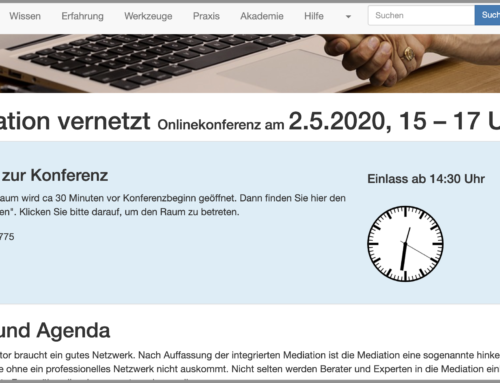Interfaces of Mediation in Family Cases
Mostly jurists think, they are omnipotent in solving family conflicts. Seen from the surface it indeed looks like that. One reason is that the law is ruling almost everything that has to be decided in case of a separaton or a divorce. Looking deeper we will see that the law is not able to resolve the most relevant questions coming up for a couple. A divorce is a process of regaining autonomy and individuality for the wife and the husband as well. To achieve best possible results parties have to combine and coordinate at least 4 very different procedures.
The different procedures are:
- Juridical procedures
- Procedures of social changing and changing the environment
- Procedures of economical changing
- Psychological procedures
Of course there is no profession providing the whole knowledge needed. But there is a chance to enhance the services to be offered. One is to add mediation and to let the parties find out solutions fitting to all of those procedures. This could be managed by a transformative mediation as the best. It can happen alongside the court procedure like court based (court annexed or court internal) mediation for example. This will work where parties are interested in cooperation for themselves. Unfortunately mostly parties are not ready for that. The more they are not, when the conflict is escalated. Then spouses are neither eager nor able to pass a voluntary process based on cooperation and mutual understanding. The higher the conflict is escalated the more they need guidance how to get there. Sometimes they even need to be forced to get out of their war of roses. In such a situation we experience, that convincing parties about mediation is not always successfully. This might have to do with the kind of advertisement. But it also has to do with the dynamic of the conflict and thinking behind that has to be changed. If there is a court procedure pending, the sitting judge is the nearest one to all the queries, which have to be resolved. For him it is quite feasible to steer parties to another way of thinking.
There was a model in Germany, which has been called Cochemer Practice. Cochem is the name of the town where the court was situated. The model might be compared with the multi door court house prototype of America. But it is different. Opposite to the multi door court house the judge doesn’t convince parties to apply a mediation. Instead he keeps the control over the process, which didn’t have to be suspended. He started to cooperate with the family office of the municipality (which is involved in each family case in Germany originally) as well as with the psychological and the juridical advisors. They founded so called working groups (Arbeitskreise). There they discussed how to deal with cases, when children are involved. The benefit was to initialize the interdisciplinary knowledge needed. The philosophy behind was, that every child needs two parents. The strategy then is to bring parties to this understanding and to where they can regain their common responsibility as parents independently from the couple’s conflict. To get there it is necessary to bring parties to some kind of cooperation. Thus the workgroups mentioned before provided a platform where the experts involved in cases could discuss and negotiate how to avoid confrontation between the parties. The result always was, that the parties in fact have been forced to cooperate. This happened because there was nobody available supporting their confrontation anymore, neither the judge, nor the psychologists or the advocates. The experience was, that parties at least did what was expected. Honestly they did first with resistance. But after a while they understood what’s behind and they always appreciated that they tried.
Another example was called Altenkirchener model. This model didn’t need that systemic background nor to establish that platform of a working group. The name of that example again was given by the name of the town where the family court was situated. In that model the judge used what is called integrated mediation. The informal meta communication which was provided by the workgroups in that Cochemer model could be established alongside the procedure in another way and less formalistic by the means of integrated mediation. Integrated mediation is much more than just to include some techniques known in mediation. It is the use of mediation as a kind of a meta procedure itself, where mediation is understood as a psychological process of cognition and a main guidance through other procedures.
Once both models have been combined and evaluated in a project which has been called “integrated mediation in family cases”. Many judges have been trained in cooperation skills and taught about the integrated mediation. An expertise proved that this way of dealing with conflicts in court procedures is most effective, cost saving and to the satisfaction of everybody involved, including the parties, the advocates, the experts and the judge.
The philosophy behind integrated mediation is not to capture parties in a juridical or mediation process, but to help them finding their way alongside the dynamic of the conflict, where the whole range of processes might be adjusted to one common aim: best conflict resolutions for everybody. The rules and guidance how to get there is given by integrated mediation, which is to be seen a mediation on a meta-level. The parties are seen holistically and as a part of an interacting family system.
See also: Divorce management





Leave A Comment
You must be logged in to post a comment.